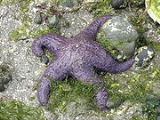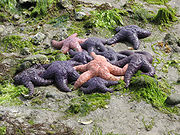
Ochre Sea Star
Encyclopedia
Pisaster ochraceus, generally known as the Purple Sea Star, Ochre Sea Star or Ochre Starfish, is a common starfish found among the waters of the Pacific Ocean
.
In Pisaster the tube feet have suckers on their distal ends which allow them to attach to the rocky substrate and live in heavily wave-swept areas.
Two species that can be mistaken as Pisaster ochraceus are Pisaster giganteus, which has blue rings around white or purple spines, and Pisaster brevispinus, which is pink with small white spines. These two species have different aboral spines and coloration which allows one to distinguish between the species. Evasterias troschelii may be confused with Pisaster ochraceus at times as well. It can be distinguished from Pisaster ochraceus because Evasterias troschelii has a smaller disk size and longer, tapering rays which are often thickest a short distance out from the base rather than at the base as in Pisaster ochraceus.
but there is no sexual dimorphism
and sexes can only be separated by the presence of eggs or sperm in the gonads. They reproduce by broadcast spawning, which occurs in the Puget Sound around May to July. There is no parental investment beyond spawning. Fertilization occurs in the water column and Pisaster ochraceous develops through several larval stages.
The reproductive system consists of a pair of gonads branching into each ray off a circular genital strand which is along the oral inner surface of the central disc. The gonads looks like a feathery collection of tubules. In females there are orange gonads and in males they are whitish. During maturation of the gametes, the gonads increase in size and can account for up to 40 percent of the sea star's weight. The gonopores are too small to be seen, and can only be found when the sea stars are spawning.

Pisaster ochraceous uses its tube feet to handle its prey. If the prey is too large to be swallowed whole, then it uses its tube feet to open shells and inserts its stomach. It digests the prey out side the body and then swallows it.
in the same way as most calcerous marine animals. This normally causes decreased growth due to the increased acidity dissolving calcium carbonate
. Researchers found that when Pisaster ochraceus was exposed to 21 °C (69.8 °F) and 770 ppm (beyond rises expected in the next century) that they survived. It is thought that this is because the animals' calcium is nodular and so it is able to compensate for the lack of carbonate by growing more fleshy tissue instead.
concept was coined, in 1969, by the zoologist Robert T. Paine
, professor emeritus of the University of Washington
, to explain the relationship between Pisaster ochraceus and Mytilus californianus, a species of mussel
.
Pacific Ocean
The Pacific Ocean is the largest of the Earth's oceanic divisions. It extends from the Arctic in the north to the Southern Ocean in the south, bounded by Asia and Australia in the west, and the Americas in the east.At 165.2 million square kilometres in area, this largest division of the World...
.
Description
This sea star has five stout rays that range in length from 10 to 25 centimeters (4 to 10 in). The rays are arranged around an ill-defined central disk. While most individuals are purple, they can be orange, orange-ochre, yellow, reddish, or brown. The aboral surface contains many small spines (ossicles) that are arranged in a netlike or pentagonal pattern on the central disk. The ossicles are no higher than 2 mm.In Pisaster the tube feet have suckers on their distal ends which allow them to attach to the rocky substrate and live in heavily wave-swept areas.
Two species that can be mistaken as Pisaster ochraceus are Pisaster giganteus, which has blue rings around white or purple spines, and Pisaster brevispinus, which is pink with small white spines. These two species have different aboral spines and coloration which allows one to distinguish between the species. Evasterias troschelii may be confused with Pisaster ochraceus at times as well. It can be distinguished from Pisaster ochraceus because Evasterias troschelii has a smaller disk size and longer, tapering rays which are often thickest a short distance out from the base rather than at the base as in Pisaster ochraceus.
Reproduction
Pisaster are mainly dioeciousDioecious
Dioecy is the property of a group of biological organisms that have males and females, but not members that have organs of both sexes at the same time. I.e., those whose individual members can usually produce only one type of gamete; each individual organism is thus distinctly female or male...
but there is no sexual dimorphism
Sexual dimorphism
Sexual dimorphism is a phenotypic difference between males and females of the same species. Examples of such differences include differences in morphology, ornamentation, and behavior.-Examples:-Ornamentation / coloration:...
and sexes can only be separated by the presence of eggs or sperm in the gonads. They reproduce by broadcast spawning, which occurs in the Puget Sound around May to July. There is no parental investment beyond spawning. Fertilization occurs in the water column and Pisaster ochraceous develops through several larval stages.
The reproductive system consists of a pair of gonads branching into each ray off a circular genital strand which is along the oral inner surface of the central disc. The gonads looks like a feathery collection of tubules. In females there are orange gonads and in males they are whitish. During maturation of the gametes, the gonads increase in size and can account for up to 40 percent of the sea star's weight. The gonopores are too small to be seen, and can only be found when the sea stars are spawning.

Lifespan
Many asteroids live to a minimal age of four to six years. The Pisaster ochraceous could live as long as twenty years.History
This species of seastar is often considered a keystone species in many intertidal regions. Pisaster ochraceus is an predator of the common mussel, Mytilus californicus and reduces its abundance. This allows for other macroinvertabrates to persist. In an experimental removal of the ochre star, it was shown that Mytilus californicus becomes almost completely dominant of the intertidal community. When Pisaster ochraceus is present there is a diverse intertidal community.Geographic range
Pisaster ochraceus can be found from Prince William Sound in Alaska to Point Sal in Santa Barbara Co., California. Pisaster found within the warmer waters from Santa Barbara County to Baja, California is Pisaster ochraceus segnis, a subspecies of Pisaster ochraceusHabitat
This sea star can be found in great numbers on mussel beds and on wave-washed rocky shores. The juveniles are often found in crevices and under rocks. Its depth range is from above the low-tide zone to 90 m in depth. Pisaster ochraceous is very durable and can tolerate a loss of thirty-percent of its body weight in body fluids.Trophic strategy
At the larval stage, Pisaster ochraceus are filter feeders and their diet consists of plankton. As an adult, Pisaster ochraceous feeds on mussels like Mytilus californianus and Mytilus trossulus. They will feed on chitons, limpets, snails, barnacles, echinoids, and even decapod crustacea.Pisaster ochraceous uses its tube feet to handle its prey. If the prey is too large to be swallowed whole, then it uses its tube feet to open shells and inserts its stomach. It digests the prey out side the body and then swallows it.
Effects from ocean acidification
A study found that Pisaster ochraceus will not be affected by ocean acidificationOcean acidification
Ocean acidification is the name given to the ongoing decrease in the pH and increase in acidity of the Earth's oceans, caused by the uptake of anthropogenic carbon dioxide from the atmosphere....
in the same way as most calcerous marine animals. This normally causes decreased growth due to the increased acidity dissolving calcium carbonate
Calcium carbonate
Calcium carbonate is a chemical compound with the formula CaCO3. It is a common substance found in rocks in all parts of the world, and is the main component of shells of marine organisms, snails, coal balls, pearls, and eggshells. Calcium carbonate is the active ingredient in agricultural lime,...
. Researchers found that when Pisaster ochraceus was exposed to 21 °C (69.8 °F) and 770 ppm (beyond rises expected in the next century) that they survived. It is thought that this is because the animals' calcium is nodular and so it is able to compensate for the lack of carbonate by growing more fleshy tissue instead.
Conservation
Pisaster ochraceus has not been evaluated by the International Union for Conservation of Nature (IUCN).In science
The keystone speciesKeystone species
A keystone species is a species that has a disproportionately large effect on its environment relative to its abundance. Such species play a critical role in maintaining the structure of an ecological community, affecting many other organisms in an ecosystem and helping to determine the types and...
concept was coined, in 1969, by the zoologist Robert T. Paine
Robert T. Paine (zoologist)
Robert T. Paine, PhD, is a zoologist and professor emeritus of the University of Washington,who coined the keystone species concept in order to explain the relationship between Pisaster ochraceus, a species of starfish, and Mytilus californianus, a species of mussel.In his classic 1966 paper, Dr...
, professor emeritus of the University of Washington
University of Washington
University of Washington is a public research university, founded in 1861 in Seattle, Washington, United States. The UW is the largest university in the Northwest and the oldest public university on the West Coast. The university has three campuses, with its largest campus in the University...
, to explain the relationship between Pisaster ochraceus and Mytilus californianus, a species of mussel
Mussel
The common name mussel is used for members of several families of clams or bivalvia mollusca, from saltwater and freshwater habitats. These groups have in common a shell whose outline is elongated and asymmetrical compared with other edible clams, which are often more or less rounded or oval.The...
.
Influence on humans
The one positive benefit for humans is that Pisaster ochraceus are admired by tourists and those visiting the intertidal zone along the Pacific Coast.Popular culture
The Ochre Sea Star has been made famous by Peach, the pink sea star character in the Disney/Pixar film Finding Nemo.External links
- http://wikis.evergreen.edu/ize2010/index.php/Pisaster_ochraceus
- http://seanet.stanford.edu/RockyShore/Echinodermata/index.html
- http://bss.sfsu.edu/holzman/courses/Fall%2003%20project/oseastar.htm
- http://www.wallawalla.edu/academics/departments/biology/rosario/inverts/Echinodermata/Class%20Asteroidea/Pisaster_ochraceus.html
- http://animaldiversity.ummz.umich.edu/site/accounts/information/Pisaster_ochraceus.html
- http://enature.com/fieldguides/detail.asp?allSpecies=y&searchText=pisaster%20ochraceus&curGroupID=8&lgfromWhere=&curPageNum=1
- http://eol.org/pages/598469
- The Biogeography of the Purple Ochre Sea Star (Pisaster ochraceus) San Francisco State University
- Ochre Sea Star, North Island Explorer

